
December 2002
The Daley News
Welcome to another addition of the Daley news.
I hope that all your trees are hanging in there through the drought and you still have dirt under your nails.
It can be difficult to satisfy the gardening urge when climate conditions challenge us this dusty way. For this reason I have been encouraged by some of our enthusiastic customers to put together some suggestions for growing trees in pots.
Our Special Feature for the Month
Tasty Tubs
Fruit Trees in Pots
When the horizon starts to look a little yellow and parched you can always freshen up your surroundings with a few large pots with leafy and fruitful trees.
Softening the edges of your patio or balcony and splashing some green across the view is one of the many good reasons to undertake the art of potted trees. Let me share with you some of the others.
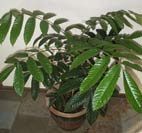
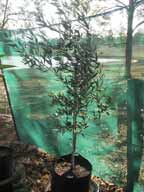 Achieve maximum diversity in minimum spaces. Even a small veranda can provide you with abundance when well tended tubbed trees surround you. I have witnessed first hand a small urban garden with 48 fruit trees in pots, and that even had a swimming pool covering half of the yard.
Achieve maximum diversity in minimum spaces. Even a small veranda can provide you with abundance when well tended tubbed trees surround you. I have witnessed first hand a small urban garden with 48 fruit trees in pots, and that even had a swimming pool covering half of the yard.
Keep you tucker on the table with easy netting options for those trees that often become breakfast for the birds. When your peaches and figs are kept at a manageable size in a tub, bag or barrel, it can be as simple as throwing a mosquito net over the tree.
Climate control - Always wanted to entertain the party with the miracle fruit trick, but your chilly winters just wont let you do it? A potted plant can easily be moved into a protected position or even become your indoor addition through the colder months as you can stretch the limits. I bet you never thought you could grow Sapodillas in Melbourne!
Balance the nutrients - With regular repotting and appropriate fertiliser application you can provide the tree with exactly what it needs to give you what you need. A combination of experimentation and education will set you on a good path. Your trees are ready for flowering, time to apply Epsom salts for that Na/K encouragement
Tough soils? - The soil beneath your feet feels more like concrete, or you just don't have faith that the sandy dunes that you call home will support your trees needs.
And for all those renters, you can take your garden with you when move on!
 Now that I have your attention, I'll pass on a few valuable horticultural tips for healthy tub plants. Here's a big picture for what to expect.
Now that I have your attention, I'll pass on a few valuable horticultural tips for healthy tub plants. Here's a big picture for what to expect.
Your mulberry tree will never be the like the giant weeping one you used to climb as a kid, that's for sure. You can expect a full sized tree to reach 2-3 times the height of the pot.
Drainage, it's a Must. Not the hardest of problems to solve but a very important one. A good idea to raise your tree off the ground with pot feet or even bricks will do fine. Make sure that your pot has more than one central drainage hole. You can always drill in some extras if that is the case.
Potting Mix. Don't skimp out on the preparation. Quality mixes are essential. The addition of water retaining / re-wetting granules are on the top of everyone's mind at the moment but these additions as well as your slow release fertiliser / compost / worm castings etc. are best mixed in when you pot it in the beginning.
Attentive fertilising. It is important to use small quantities of slow release fertilisers regularly. Liquid feeds like seaweed, fish tea or worm juice sounds like an appetising treat for the trees once a month don't you think. Foliar fertilisers can also be a good option.
Tree selection. The shorter the trunk the better. Keep the nutrient available for the fruit and encourage branching as early as possible. It may be necessary to prune or tip the tree when you have reached the size and shape that you are looking for.
Water wise. Potting mix can be difficult to wet thoroughly again once it had dried out. A spike sprinkler on a dribble every other day and a heavy soak once a week is optimal.
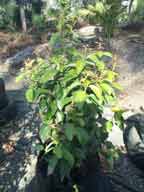 Mulching isn't madness. Keep all those good habits alive. Even potted plants appreciate the water retention and cooling qualities of mulch. Keep the mulch clear of the trunk though.
Mulching isn't madness. Keep all those good habits alive. Even potted plants appreciate the water retention and cooling qualities of mulch. Keep the mulch clear of the trunk though.
Repotting. Root pruning Every three years is good, every two years is better. It will make a radical difference to the performance of your tree. The general rule is to carefully shave off approximately 5 cm all the way around the root ball. Winter time is best for most trees but some of your more sensitive subtropical fruits may appreciate the prune in the spring when they can push away again quickly.
What pot is a good pot? Those lovely old wine barrels and old fashioned washing tabs may look great but wait till you have to turn that upside down and root prune, you might need your whole neighbourhood to help out and then you'll have to share ALL the fruit. But wait! before throw them out, an easier alternative is to put your trees into manageable plant bags (up to 30L is good) and then slip the bags into the feature pot. Cover it with mulch and no one will know. This will also help to insulate the soil, keeping it at a more constant temperature. One last warning, avoid the concave pots at all costs. Near impossible to repot!!
Remember planting in pots is not a short cut for production, they will still require your time and attention. If your expectations are realistic you will not be disappointed.
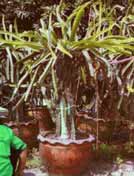 To throw in a few wild ideas so that you can take this ideas and explore it creatively, In South East Asia the Malabar Chestnut is featuring as a regular house guest with two or three chestnuts planted into the one pot to braid the trunks for an interesting effect on their way to fruiting.
To throw in a few wild ideas so that you can take this ideas and explore it creatively, In South East Asia the Malabar Chestnut is featuring as a regular house guest with two or three chestnuts planted into the one pot to braid the trunks for an interesting effect on their way to fruiting.
Have a look at this fruitful opportunity for the curious and delicious pitaya.
How about having a bush food balcony. The Davidson plum is a very happy potted plant in your partly shady patios.
Write in and tell us your success story with fruit trees in pots and I'll forward you a special gift from Daleys.
Our Special Trees of the Month;
From our Exotic Fruits Section -
Horseradish or Drumstick Tree- Moringa olifera
Who would ever have thought that such an inconspicuous tree
could offer us so much!!
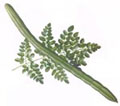 CULTURE
CULTURE
Originating in India, it has spread in popularity to most of the tropical world attracting interest for both its ornamental purposes and for its multitude of uses.
USE
The roots can be used as a very tasty substitute for Horseradish. The flowers, shoots, and foliage are all edible with a spicy flavour. The nutritionally rich leaves have high nutritional qualities and are often sun-dried and stored for off-season use in developing countries. Young pods are often cooked like beans in curries with a flavour similar to asparagus. You may be lucky enough to find these delights in a delicatessen marked as 'drumsticks'. The seeds, when fried and eaten taste similar to delicious peanuts and can be also be pressed for oil called 'ben' oil. This nondrying oil is used for oiling machinery and watches, in salad oil, and in soaps. The tree makes an excellent hardy fodder tree in frost frees warmer areas.
The list still continues with the Moringa seeds able to settle clay and silt and clarify turpid water, offering local alternatives to water treatment in rural tropical areas. Horseradish Tree contains a physiologically active constituent that has been shown to be effective in a broad range of health needs, particularly malnutrition.
DESCRIPTION
The hardy deciduous tree is extremely fast growing to reach its height of 5-6m tall. It is often mistaken for a legume tree. It has soft drooping branches with fern-like leaves. The white fragrant flowers are borne in loose clusters followed by the long narrow seed pods.
From our Rainforest Section-
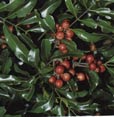 Rosewood - Dysoxylum Fraserianum
Rosewood - Dysoxylum Fraserianum
This medium to large evergreen rainforest timber tree will provide you with dense shady crown of dark green glossy foliage. Its attractive fruits range from cream through to red. It can be slow to establish but once it settles in it proves a hardy and vigorous tree with relatively good cold tolerance. In open garden situations it can be expected to reach 20-25m.
Native Frangipani - Hymnosporum flavum
 This fast growing native tree is a very rewarding addition to any garden, large or small. Its beautiful green foliage of hardy nature will be marvelled at in the driest of times. Its masses of spring yellow / white flowers are heavily scented with a sweet frangipani fragrance. The trees are adaptable to a wide range of conditions from shaded rainforest to open country to coastal planting. They are frost and wind tolerant and tend to perform and flower best in the tougher sites. The tree can range from a shrub to a small tree stretching up to 10m in the more favourable conditions.
This fast growing native tree is a very rewarding addition to any garden, large or small. Its beautiful green foliage of hardy nature will be marvelled at in the driest of times. Its masses of spring yellow / white flowers are heavily scented with a sweet frangipani fragrance. The trees are adaptable to a wide range of conditions from shaded rainforest to open country to coastal planting. They are frost and wind tolerant and tend to perform and flower best in the tougher sites. The tree can range from a shrub to a small tree stretching up to 10m in the more favourable conditions.
This decorative tree is available in Forestry tubes from Daleys for just $1.95
The trees listed above and many more are available at Daleys Nursery.
See our website at https://www.daleysfruit.com.au.htm and go straight to the shopping trolley to order these plants or call in and see Emma at the Nursery for more information.
From our Bush Food Section -
Blue Quandong - Eleocarpus grandis
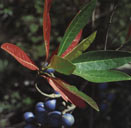 This spectacular feature tree is second to none in a park or large garden. You can witness the emergence of its prominent buttresses within 5 years. The open layered crown is host to a splay of brightly decorative scarlet red and rich green leaves formed in whorls. Birds and marsupials and even humans are attracted to the bright blue fruits that have a thin covering of tasty flesh surrounding the seed. The convoluted pattern of the seed resembles a 'brain'. The very similar seeds of a close relative fetch a high price in India as the sacred 'Radruksha' beads and are often used as religious Rosary beads. Fruits ripen from August to January. The timber is highly prized and frequently planted in cabinet timber plantations and as a pioneer in restoration works.
This spectacular feature tree is second to none in a park or large garden. You can witness the emergence of its prominent buttresses within 5 years. The open layered crown is host to a splay of brightly decorative scarlet red and rich green leaves formed in whorls. Birds and marsupials and even humans are attracted to the bright blue fruits that have a thin covering of tasty flesh surrounding the seed. The convoluted pattern of the seed resembles a 'brain'. The very similar seeds of a close relative fetch a high price in India as the sacred 'Radruksha' beads and are often used as religious Rosary beads. Fruits ripen from August to January. The timber is highly prized and frequently planted in cabinet timber plantations and as a pioneer in restoration works.
The Blue Quandong is available from Daleys in 140mm pots for $7.75
Small Leaf Tamarind - Diploglottis Cambellii
 The first documentation of the Small Leaf Tamarind was in 1891. With only approximately 30 trees are left remaining in the wild of Northern NSW this endangered species is attracting quite a bit of attention both amongst the bush food enthusiast and the conservationists.
The first documentation of the Small Leaf Tamarind was in 1891. With only approximately 30 trees are left remaining in the wild of Northern NSW this endangered species is attracting quite a bit of attention both amongst the bush food enthusiast and the conservationists.
This small evergreen tree can be expected to reach 7-8m in an open garden environment providing a beautiful rich green spreading crown. As a mature tree will capture the eye with its interesting fruit from which the bright red-coated seeds emerge in mid summer. The tasty tangy fruit is a refreshing treat eaten raw or it can be used creatively in chutneys and sauces.
Also makes a excellent specimen tub plant as a young tree.
Has your bush food garden left you curiously scratching your head wondering what to do with it all. Here is a rather tempting recipe for Small leaf Tamarind chutney
This tasty and tangy chutney offers the best of Australian bush flavours and fragrance. Makes a great accompaniment to curries or spice up your summer lunch of breads and salads.
|
Australian Tamarind Chutney
|
|
|
Ingredients: 500 g finely diced onions |
|
Method:
 Simmer the diced onions in half of the vinegar until soft (10 minutes) in a large heavy based saucepan
Simmer the diced onions in half of the vinegar until soft (10 minutes) in a large heavy based saucepan
Add chopped fruit, tamarind, spices (tied in a muslin bag), salt, ginger and a further 100 ml of vinegar
Cook slowly with the lid on until the fruit is soft, stirring occasionally
Add the remainder of vinegar and slowly stir in the sugar
Remove spice bag and gently boil until the chutney thickens.
Ladle into bottles and seal while still hot
Let stand for 3-4 weeks to mature before indulging
Enjoy!!
I'd like to introduce you to John Picone
![]() John Picone from Tintenbar Northern NSW has shoes that I think may of our readers would like to fit into. An ex Sydney-sider, he moved to the North Coast in 1987 in order to get a little closer to his dream lifestyle. Just 15 years later its hard to believe that even a dream could be this good. Getting his hands into the soil after a career in Graphic design was not a difficult transition he tells us. His 60 acres frost free property overlooks the ocean on some of the north coasts best Red Krasnozem soils.
John Picone from Tintenbar Northern NSW has shoes that I think may of our readers would like to fit into. An ex Sydney-sider, he moved to the North Coast in 1987 in order to get a little closer to his dream lifestyle. Just 15 years later its hard to believe that even a dream could be this good. Getting his hands into the soil after a career in Graphic design was not a difficult transition he tells us. His 60 acres frost free property overlooks the ocean on some of the north coasts best Red Krasnozem soils.
John has made very practical use of his love for the exotic and has es tablished now one of the most diverse and well managed fruit orchards in the area. The farm is littered with tropical fruits like the Soursop, Canistel, Rollinia, Abiu, Jackfruit, as well as some of the more unusual fruits like the Madrono, Sun sapote, Maprang, Santol, Saba nut, and the Pink avocado (Ancola) Of course he has made space in his orchard for the more traditional Mediterranean fruits familiar to him from his homeland Italy, like the Pomegranate, Chestnuts, Olives, and the half dozen varieties of his favourite Figs. Not to forget the Walnuts which depsite much scepticism from other growers has produces a crop worth pickling this year.
tablished now one of the most diverse and well managed fruit orchards in the area. The farm is littered with tropical fruits like the Soursop, Canistel, Rollinia, Abiu, Jackfruit, as well as some of the more unusual fruits like the Madrono, Sun sapote, Maprang, Santol, Saba nut, and the Pink avocado (Ancola) Of course he has made space in his orchard for the more traditional Mediterranean fruits familiar to him from his homeland Italy, like the Pomegranate, Chestnuts, Olives, and the half dozen varieties of his favourite Figs. Not to forget the Walnuts which depsite much scepticism from other growers has produces a crop worth pickling this year.
His experimentation with just about everything that will grow on the North Coast led him to his most recent adventure. Three years ago John planted overone thousand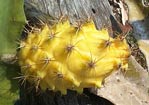 posts, followed quickly by the unusual Pitaya. Now he has one of the finest examples of commercial pitaya orchards around, growing both the yellow skin / white flesh and the red skin / red flesh varieties for his distant Sydney friends. Truly amazing what one person can do when driven by passion.
posts, followed quickly by the unusual Pitaya. Now he has one of the finest examples of commercial pitaya orchards around, growing both the yellow skin / white flesh and the red skin / red flesh varieties for his distant Sydney friends. Truly amazing what one person can do when driven by passion.
CHRISTMAS SPECIALS
This year Daleys has decided on a very simple Christmas special. We will be distrubing stockings frull of rain to all good gardeners. Wouldn't that be wonderful. All your Christmas's come at once.
New Year Special - For every purchase over $200, Daleys would like to offer our mail orders and retail customers a free copy of Louis Glowinski's book THE COMPLETE OF FRUIT GROWING IN AUSTRALIA valued at $50.00
Next Issue
Over the Christmas break Greg is travelling to Vietnam and I am off to the Solomon Islands next issue we will share you the fruitful cornicopia of information and inspiriation from these colourful countries. Have a wonderful Christmas and see you again in the New Year.
We will also feature Chef, Ward Gunn, specialist in cooking with wild foods





